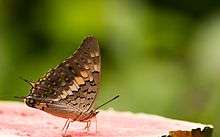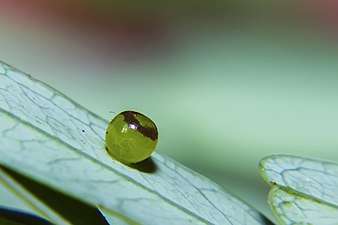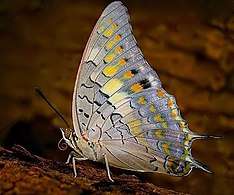Charaxes solon
Charaxes solon, the black rajah,[2][3] is a butterfly species found in tropical Asia. It belongs to the Charaxinae (rajahs and nawabs) in the brush-footed butterfly family (Nymphalidae).[1][2][3][4]
| Black rajah | |
|---|---|
.jpg) | |
| Upper side | |
 | |
| Underside | |
| Scientific classification | |
| Kingdom: | Animalia |
| Phylum: | Arthropoda |
| Class: | Insecta |
| Order: | Lepidoptera |
| Family: | Nymphalidae |
| Genus: | Charaxes |
| Species: | C. solon |
| Binomial name | |
| Charaxes solon (Fabricius) 1793 | |
| Synonyms | |
| |
Description

The black rajah is a medium-sized butterfly with a 70 to 80 mm wingspan. Above, the butterfly is dark brownish black with greenish or white discal bands across both the wings. The band is broken into spots towards the apex of the forewing. The hindwing has two similar-sized tails at veins 2 and 4. These tails are longer in the females and more pointed in the males.[5]
Male
The upper side is blackish olive-brown, palest basally. Forewing with a transverse discal recurved series of eight yellow spots increasing in size from near the costa, the upper spots mostly rounded, the lower spots being broad and irregularly quadrate with uneven exterior; also a yellow subcostal spot between the lower subcostal veinlets and upper radial, and a smaller spot outside end of the cell above the upper median veinlet; a marginal lower row of minute yellow spots which are more or less obsolescent anteriorly.
Hindwing with a transverse discal yellow irregular band, decreasing posteriorly; a submarginal row of small, yellow lunules, and a marginal row of small geminate spots, those at the anal angle being greenish-grey. The underside is lilac-grey, of a more or less pale or darker tint, but dullest at the base, and purplish-tinted externally. Both wings with white transverse discal markings as on upperside, but each inwardly-edged by a black line; the basal area crossed by irregular black slender lines.
Forewing also with three basal black spots in the cell, a submarginal row of ochreous-yellow spots with posteriorly increasing black borders, and a marginal lower row of indistinct purplish-white lunules. Hindwing also with a discal more or less defined irregular row of black-edged purplish-white lunules, and a submarginal row of ochreous-yellow spots with blackish outer borders, followed by a marginal row of small, more or less ochreous-yellow or greenish-ochreous lunules surmounted by an indented black line and white speckles above, and broken lunate white spots below; the extreme margin and tails being blackish-edged."[1]
Female
The upperside as in the male, with the markings somewhat larger. Underside as in the male."[1] The body is dark olive-brown above; the collar, front and palpi are black above, spotted with white; the palpi, body beneath, and the legs are whitish; the fore tibiae are brown above; the antennae black and the eyes reddish."[1]
Egg
Its egg is transparent yellow and spherical, with longitudinal ridges. It has a dark red uneven band around its upper half.
Caterpillar
The caterpillar is dark green with irregular rows of yellow tubercles. The caterpillar is cylindrical and may have a round white blotch on the seventh segment. The head is outcurved and has horns and spines. The pupa is short, dark green and it has a lateral longitudinal line which is marbled white.[6]
Range
The butterfly is found in South Asia and South East Asia. It occurs in Sri Lanka, India, Myanmar, Indochina, Cambodia, Peninsular Malaysia, Singapore, Sumatra, Sulawesi, the Philippines (Palawan, Sulu Archipelago). In India, the butterfly occurs in South India, and the Himalayas right from Kumaon, Sikkim, into Bhutan, through Assam and onto Myanmar. At least in South Asia, it is not rare.[2][3][7]
Ecology
The black rajah is generally a low-elevation butterfly and can be found at altitudes up to 1950 m (6500 feet) ASL.
The caterpillars generally feed on Fabaceae, such as tamarind Tamarindus indica.[6] At least on Borneo but probably elsewhere too, adults do generally not visit carrion or old fruit to drink liquids.[8]
Gallery
 Egg
Egg Caterpillar
Caterpillar.jpg) Black Rajah ( Charaxes solon) adult from Tirupati, Andhra Pradesh
Black Rajah ( Charaxes solon) adult from Tirupati, Andhra Pradesh_in_Kawal_WS%2C_AP_W_IMG_1803.jpg) Adult in Kawal Wildlife Sanctuary, India
Adult in Kawal Wildlife Sanctuary, India In Chandannagar, West Bengal, India
In Chandannagar, West Bengal, India On Millettia pinnata at Mahim Nature Park in Mumbai, India
On Millettia pinnata at Mahim Nature Park in Mumbai, India Upper side
Upper side
Footnotes
| Wikimedia Commons has media related to Charaxes solon. |
| Wikispecies has information related to Charaxes solon |
-

- Savela, Markku. "Charaxes Ochsenheimer, 1816 Charaxes Rajahs". Tree of life - insecta - lepidoptera. Retrieved 2018-03-14.
- R.K., Varshney; Smetacek, Peter (2015). A Synoptic Catalogue of the Butterflies of India. New Delhi: Butterfly Research Centre, Bhimtal & Indinov Publishing, New Delhi. p. 157. doi:10.13140/RG.2.1.3966.2164. ISBN 978-81-929826-4-9.
-

- Wynter-Blyth (1957): pp. 146-147
- Haribal (1994): p.151
- Haribal (1994): p.151; see also Savela (2007) for references.
- Hamer et al. (2006)
References
- Evans, W.H. (1932). The Identification of Indian Butterflies (2nd ed.). Mumbai, India: Bombay Natural History Society.
- Gaonkar, Harish (1996). Butterflies of the Western Ghats, India (including Sri Lanka) - A Biodiversity Assessment of a Threatened Mountain System. Bangalore, India: Centre for Ecological Sciences.
- Gay, Thomas; Kehimkar, Isaac David; Punetha, Jagdish Chandra (1992). Common Butterflies of India. Nature Guides. Bombay, India: World Wide Fund for Nature-India by Oxford University Press. ISBN 978-0195631647.
- Hamer, K.C.; Hill, J.K.; Benedick, S.; Mustaffa, N.; Chey, V.K. & Maryati, M. (2006): Diversity and ecology of carrion- and fruit-feeding butterflies in Bornean rain forest. Journal of Tropical Ecology 22: 25–33. doi:10.1017/S0266467405002750 (HTML abstract)
- Haribal, Meena (1992). The Butterflies of Sikkim Himalaya and Their Natural History. Gangtok, Sikkim, India: Sikkim Nature Conservation Foundation.
- Kunte, Krushnamegh (2000). Butterflies of Peninsular India. India, A Lifescape. Hyderabad, India: Universities Press. ISBN 978-8173713545.
- Savela, Markku. "Charaxes Ochsenheimer, 1816". Lepidoptera and Some Other Life Forms. Retrieved November 1, 2017.
- Wynter-Blyth, Mark Alexander (1957). Butterflies of the Indian Region. Bombay, India: Bombay Natural History Society. ISBN 978-8170192329.